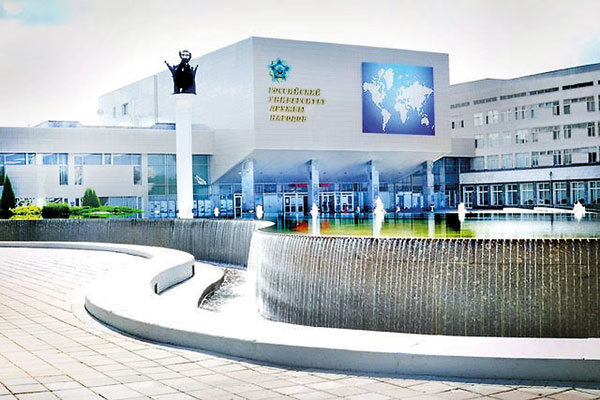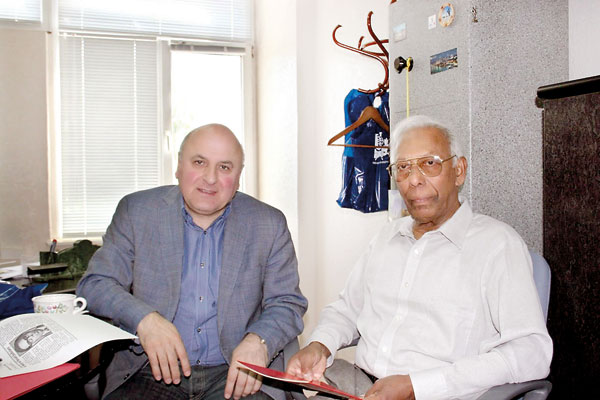Sunday Times 2
Moscow’s Friendship University resembles a mini-United Nations
View(s):
The People's Friendship University in Moscow: The university’s high quality of education was evident from its early days
The Peoples’ Friendship University of Russia, a renowned, world-class educational and research institution in Moscow, celebrates its 60th Anniversary from February 5-7, culminating in a grand concert at the Kremlin Palace of Congress presided by Russia’s President Vladimir Putin.
It was a prodigious achievement for then Premier Nikita Khrushchev to open this University in 1960, just less than half a century after the 1917 Russian revolution, and less than two decades after winning World War II that ravaged the former Union of Soviet Socialist Republics (USSR) with a loss of over 27 million of its people.
A beacon of hope
First, the landmark event that influenced the opening of this university was the liberation of many Asian, African and Latin American countries from colonial rule and oppression.
Secondly, it was the ideal time to open up the former Soviet Union to the world to display its thriving economy, marvels of industrialisation, advances in science, technology and medicine, escapades into outer space, and basking in the glory of a superpower.
Thirdly, in keeping with its socialist tradition of helping developing countries, the university has annually offered thousands of fully paid graduate scholarships in medicine, engineering, jurisprudence, and other sciences to provide vitally needed qualified cadres to develop those newly liberated nations. That is a magnanimous contribution – unprecedented in history.
As Nelson Mandela said “Education is the most powerful weapon which you can use to change the world”.
A mega-university
As a frequent visitor to the Friendship University since 1960s, I have had the rare privilege of witnessing its radical transformation — the exponential growth of buildings, faculties, programmrs and institutes, and its number of students.
In 1960, the University had 539 students from 59 countries in six faculties in different locations in Moscow. By 1964, the University began to build a new campus to accommodate all faculties and students in one location.

Somar Wijayadasa in Moscow with Prof Aslan Abashidze, Dean of the Law Faculty of the People’s Friendship University of Russia
From the beginning to date, the university has a well-qualified staff — Professors mostly with PhDs and higher academic qualifications.
When I defended my thesis in 1967, the dissertation committee consisted of seven eminent international jurists, chaired by Feodor Kozhevnikov, a former judge of the International Court of Justice — a high standard indeed.
The university’s high quality of education was evident from its early days. The United Nations Educational, Scientific and Cultural Organization (UNESCO) was the first to recognise the excellence of degrees conferred by the Friendship University.
Among many awards it has received is the UNESCO Gold Medal, in 2010, for its inestimable contribution towards training specialists from developing countries.
With their superior global rankings, university graduates with a master’s degree in any discipline could gain direct admission into PhD programmes in Western universities.
For example, I was admitted to the Hague Academy of International Law, and to PhD programmes at the Vienna University, and the School of Law at the New York University purely on the grades of my master’s degree programme, but my heavy workload and travel schedules at the United Nations disrupted my doctoral studies.
Today, the Friendship University has reached extraordinarily high standards, thanks to the tenacious management skills of its dynamic Rector, Prof. Vladimir Mikhailovich Filippov, Doctor of Physics and Mathematics.
Dr. Filippov is an (1973) alumnus of the Friendship University and an academician of the Russian Academy of Education, a former Minister of Education of the Russian Republic, and has won many academic awards. He holds the chairmanship of several educational committees of UNESCO in Paris.
Let knowledge unite us
In keeping with its motto “scientia unescamus”, the university unites people of different nationalities by means of knowledge, and trains highly-qualified specialists who are capable of working in any country of the world.
In that spirit, every year, the university admits nearly 2,000 students from more than 150 countries. At present, more than 150,000 of its graduates, including more than 6,000 doctors of science (PhDs) work in 180 countries.
Among its prominent graduates are: Mahmoud Abbas, Chairman of the PLO; Michel Djotodia, President of Central African Republic; Daniel Ortega, President of Nicaragua; Hifikepunye Pohamba, Former President of Namibia; Bharrat Jagdeo, former President of Guyana; Porfirio Lobo Sosa, former President of Honduras; Yousuf Saleh Abbas, former Prime Minister of Chad; Karim Masimov, former Prime Minister of the Republic of Kazakhstan, to name a few.
Other influential alumni includes ministers, judges, ambassadors, academicians, senior United Nations officials, and thousands of doctors and engineers and other professionals in hundreds of countries from Angola to Zimbabwe.
Friendship University graduates return to their countries — that have suffered for centuries under foreign rule and exploitation — to contribute not only for the scientific advancement of their countries but also to embark on their arduous struggle to win economic independence, develop their national economies, and achieve social progress.
That exemplifies Abraham Lincoln’s words “The philosophy of the school room in one generation will be the philosophy of government in the next”.
The whole world in one university
The Friendship University campus is located in the South-West of Moscow — about 20 minutes from the Kremlin and Red Square.
It occupies 50 hectares (125 acres) and consists of 27 academic and hostel buildings, sport facilities and stadiums, a medical and diagnostic centre, hundreds of scientific laboratories, a library, an International Club, a shopping centre and 32 multinational cafés — all resembling a cosmopolitan city within the city of Moscow.
According to the university, the current enrollment of students at the Moscow campus and at its Sochi Institute are about 33,500 internal and external students, post-graduate students, residents and interns from 157 countries.
On average, about 9,000 students live in the Moscow campus. The approximate distribution of students by country and region are: Asia – 2,324; Latin America – 565; Africa – 1,289; Middle East – 861; CIS and Baltic countries – 3,510; and Western Europe – 349 students.
Referring to the vast multicultural composition of its student body, Rector Filippov says “our students not only obtain a university degree to fulfill their professional ambitions, but also gain invaluable experience in dealing with different cultures, and broaden their social and cultural horizons”.
Today, the University employs 2,800 highly qualified faculty members, including more than 600 doctors of sciences and 1,400 candidates of science, and about 150 foreign teachers.
One noteworthy tradition that continues to date is the assiduous dedication of its professors who strive to ensure that all students excel in their studies, and graduate as well qualified professionals.
Infinite education opportunities
Today, the training of specialists at the university is carried out according to 472 programmes of various levels of education, including 74 programmes in foreign languages (English and Spanish) at the various faculties, institutes and academies of the University.
It is the only university in Russia that has such a multidisciplinary structure that is characteristic of leading classical universities in the world.
Among the phenomenal changes from my days in the 1960s is that today you can follow many courses in the English medium. Regardless, all foreign students, after a year in Russia, speak fluent Russian.
Another distinct improvement is the change in 1989 from a single all-inclusive five-year master’s degree programme into a multi-tiered system of higher education.
Today, the university offers a variety of bachelors, masters, and Ph.D degrees in 76 disciplines. It has more than 30 master’s programmes in English and Spanish languages, and has more than 113 joint master’s and double diploma programmes with famous universities of the world.
A mini United Nations
Having worked in several organisations of the United Nations system – IAEA, FAO, UNESCO, WHO/UNAIDS – and most of my career representing these organisations at the UN Headquarters in New York, I can vouch that the atmosphere in the Friendship University campus bears a resemblance to the United Nations in New York.
A couple of summers ago, my wife and I casually visited the university (as we always do when we are in Moscow) not realising that the graduation ceremonies were in progress.
The main building’s massive lobby was filled with beaming graduating students, their families, and ambassadors of various countries — some dressed in their national costumes — and the jubilant atmosphere truly resembled a mini United Nations.
As we were introduced to the gathering, many thronged around us to talk about student days in the 60s, and about employment in UN organisations.
The university has a cooperative and friendly attitude — one of respect and mutual assistance. With multinational traditions and customs, cuisine, dancing and music — the whole world is in one Moscow street.
If education is the ultimate gift one can give a child, then, the Peoples’ Friendship University of Russia has given that gift of education to more than 150,000 deserving young men and women from many countries around the world – who otherwise would never have had the opportunity to receive a higher education — especially in a foreign country.
(Somar Wijayadasa, an International lawyer is a graduate of the Friendship University. He worked for IAEA and FAO (1973-1985), was UNESCO delegate to the UN General Assembly (1985-1995), and was the Representative of UNAIDS at the United Nations from 1995-2000.)

